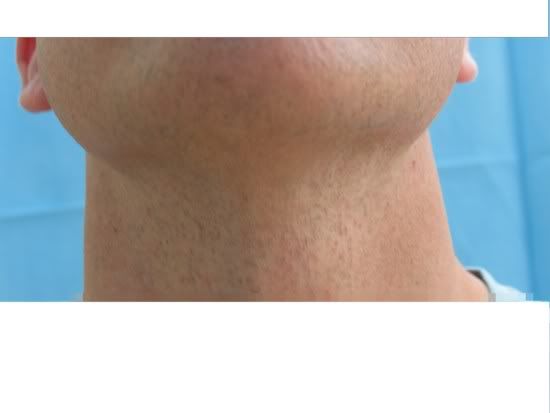This was old, just reposted by hairsite in the hair transplant forum. This is hair multiplication, literally! No wonder everybody in the hair transplant forum is talking about using beard hair lately, i think it has real potential for hair multiplication, best of all, no FDA approval needed and doctors are already doing it.
"Auto-Cloning" of Beard Hair Used to Increase Supply of Donor Hair for Transplantation to ScalpNEW YORK (October 16, 2003)- Beard whiskers, carefully removed, may offer an inexhaustible supply of hair for transplantation to the scalp. With proper removal technique, the continued growth of beard hair at the removal site is not compromised.
This “auto-cloning” of beard hairs may be particularly effective for balding men who have little scalp hair left for transplantation, and for persons whose scalps have been scarred by injury or burns, according to Gary Hitzig, MD, New York.
Dr. Hitzig, a physician hair restoration specialist in private practice, reported on the successful “auto-cloning” of beard hair today at the 11th Annual Meeting of the International Society of Hair Transplantation Surgery (ISHRS). The ISHRS is meeting October 15-19 at the Marriott Marquis Hotel, New York City.
The transplantation of beard whiskers to the scalp without compromising continued growth of the beard was undertaken by Dr. Hitzig following research reported by Dr. J.C.Kim, Pook University, Korea. Dr. Kim reported research showing that each human hair can theoretically be split into two, and produce two hairs from one. This requires enough “stem” cells be present in each portion to regenerate the full follicle.
Dr. Hitzig designed a study, enlisting five men, that was based on Dr. Kim’s work. Using a specially designed “tweezing” tool, Dr. Hitzig removed beard hairs from the men by extracting enough of the follicle to produce a new one when implanted, but also leaving enough of the follicle to continue growing new beard hairs at the donor site. This suggested that beard hair would not only not be depleted, but could serve as a non-depleting source of hair for future transplantation. In men who experience hair loss over most of the scalp, so much hair may be lost that little or none is left for transplantation. The lack of donor scalp hair may limit the benefits that these men could realize from transplantation. A non-depleting supply of donor hair could a substantial benefit for these men.
Dr. Hitzig chose coarse hair from the chin or sideburns for transplantation in the reported study; the coarse hair demonstrated greater vitality than finer hair after it was transplanted to the scalp. Earlier studies had shown that less coarse hair had less vitality after transplantation; patients also experienced less discomfort from plucking of hair from the chin or sideburns.
The five men in the study shared the characteristics of age (40-57 years old), having had previous hair transplants, and lack of adequate donor scalp hair for future transplants as balding progressed.
Results of the study demonstrated the potential of bear hair transplantation to the scalp, Dr. Hitzig reported. With the use of coarser chin and sideburn hair, the “take” of beard hairs transplanted to the scalp was more than 80%. Post-transplant hair counts at six months showed increased density of approximately 25 hairs per 30 hairs transplanted. Examination of beards in the five men showed no change in pre-plucked density, suggesting that the follicles left intact had continued to produce new hairs.
The transplanted beard hairs retained their coarse “chin whisker” characteristics after transplantation into the scalp. The thickness of the transplanted beard hairs provided good coverage of the scalp at the transplant site, Dr. Hitzig said.
Expanding upon successful beard hair transplantation in the five men studied, Dr. Hitzig has completed a preliminary study in which several beard hairs were transplanted into scars created by previous harvesting of donor scalp hair. Results of this preliminary study have been encouraging enough to indicate the potential of beard hair transplantation into scarred scalp, Dr. Hitzig said.
Although “auto-cloning” was used to describe Dr. Hitzig’s procedure, no actual cloning was involved. Dr. Hitzig’s process is a transfer of hair and its genetic programming to a new site, where the hair continues to replicate the appearance it had at the donor site.
The “cloning” usually reported in hair restoration studies is in vitro (laboratory dish) replication of hair follicle cells-a technique that is more correctly called tissue engineering. Varying degrees of success have been reported in studies of in vitro replication. True cloning-transfer of genetic material into a cell to replicate a “mother” cell-has not been reported for purposes of hair restoration.
The ISHRS is the world’s largest not-for-profit professional organization in the field of hair restoration surgery, with 512 physician members in 45 countries. The organization was founded in 1992 to promote the advancement of the specialty of hair restoration surgery through education, information-sharing, and observance of ethical standards.
[Hitzig GS. Auto-cloning using beard hair. Cosmetic Dermatology 2003; 16:63-69.]


